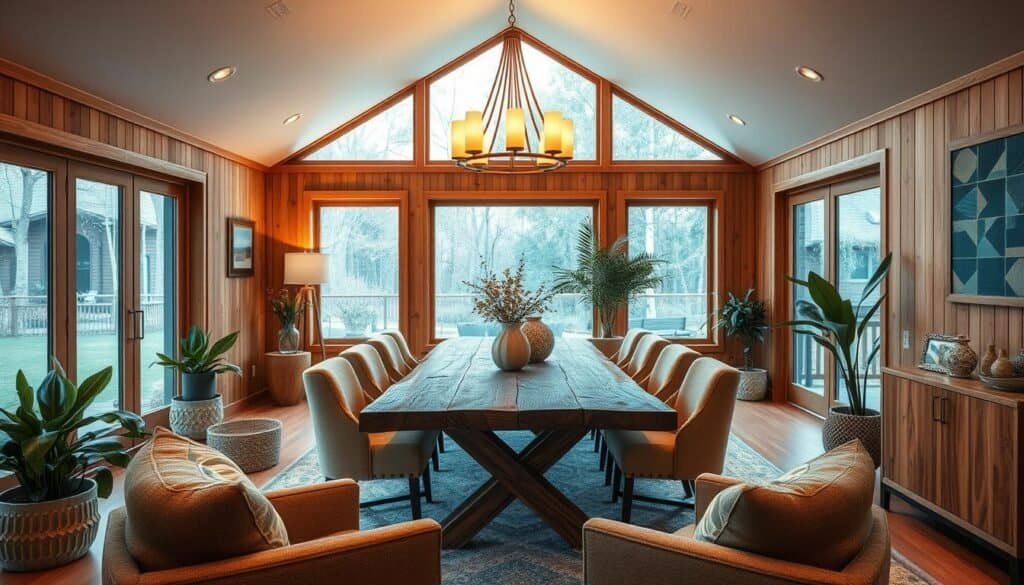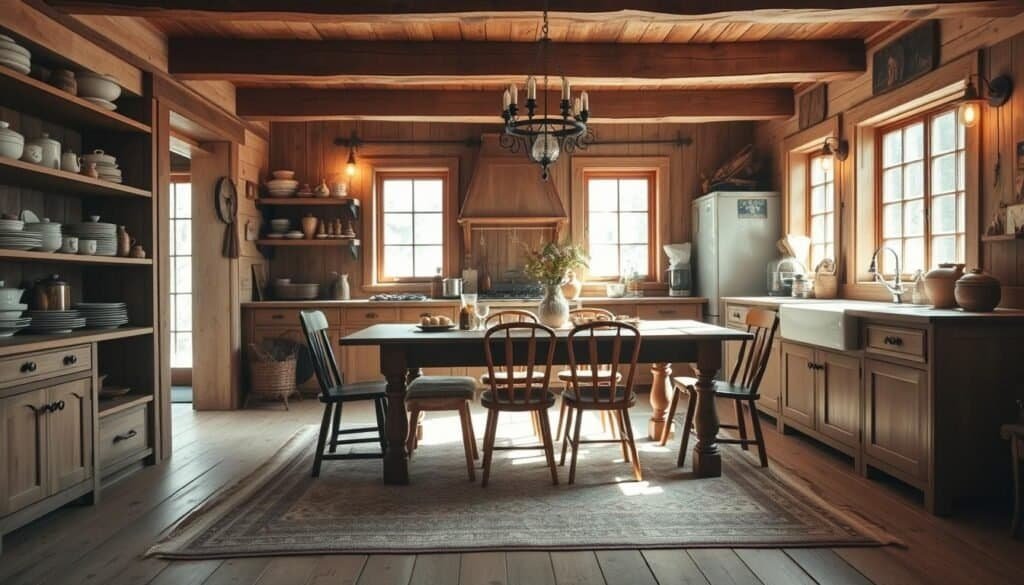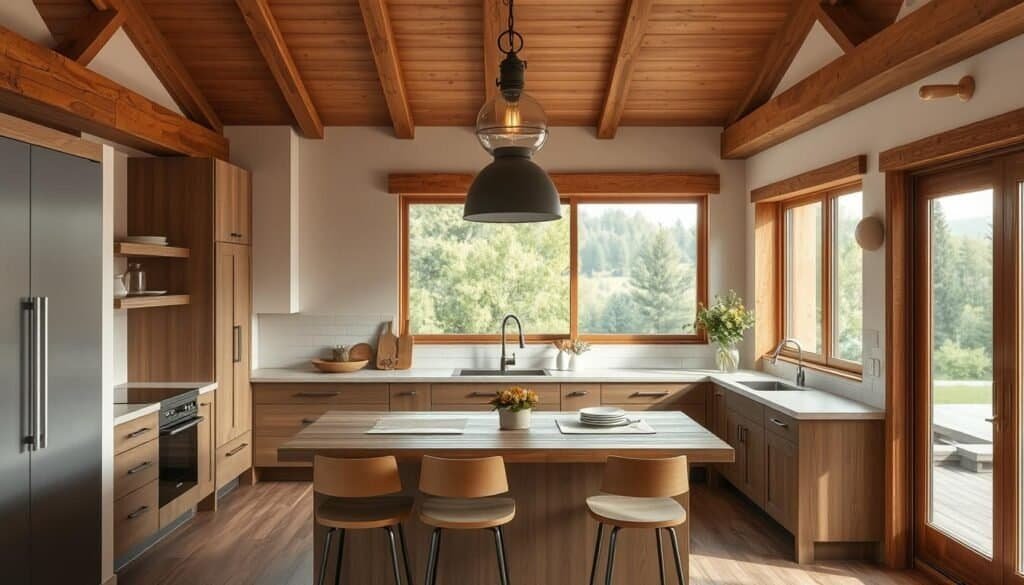Creating a warm and inviting dining space is a great way to bring family and friends together. Building your own handmade rustic dining table is a beautiful centerpiece for your home. It’s also a rewarding project that you can be proud of.
With rustic wood projects, you can create a unique piece of furniture that reflects your personal style. By following a guide on how to build your own dining table, you can ensure that your project is both functional and aesthetically pleasing. In this article, we’ll explore the process of creating your own farmhouse furniture diy project. We’ll provide you with the inspiration and guidance you need to get started.
The Timeless Appeal of Farmhouse Dining Tables
Farmhouse style dining tables are loved for their timeless charm. They blend rustic beauty with versatility. This makes them perfect for many home decor styles.
These tables add warmth and coziness to any dining area. They’re popular in both modern and country farmhouse decor. Homeowners love the rustic look, often using reclaimed wood and vintage pieces.
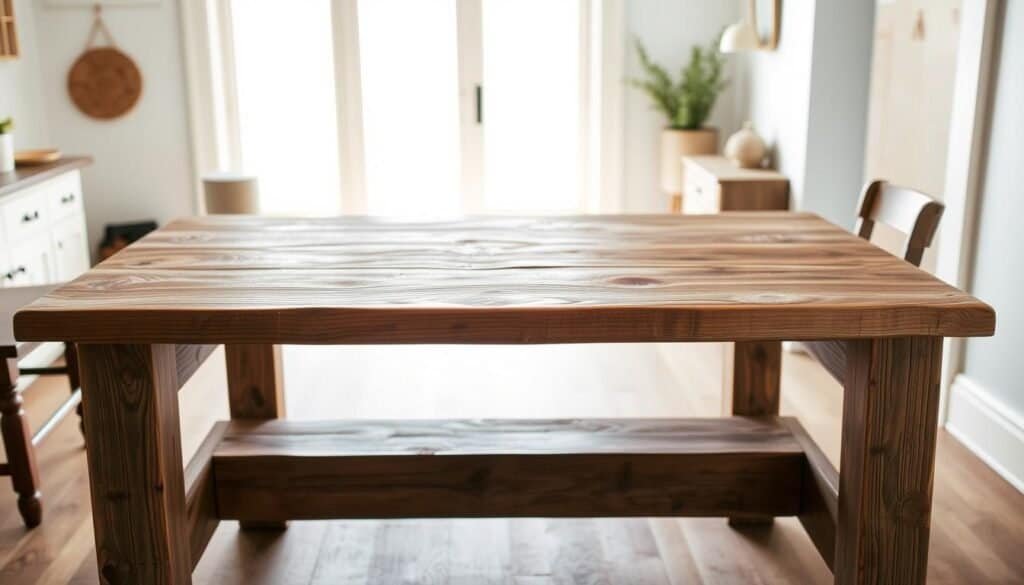
The farmhouse aesthetic focuses on natural materials like wood. It often has a distressed look. This style works well in both rural and urban homes, bringing country charm to city spaces.
Farmhouse dining tables are both beautiful and practical. They can be dressed up or down. This makes them great for everyday meals and special events.
Adding a farmhouse dining table to your home is easy. Just pick the right table and choose furniture and decor that match its rustic charm. Whether you want a modern or traditional look, these tables will be a favorite in your home.
Essential Tools for Building Your Own Dining Table
Starting a woodworking project for your dining table requires the right tools. You’ll need basic tools for cutting and assembling your table. These tools are the foundation of your project.
Key tools include a table saw for straight cuts, a miter saw for angled cuts, and a drill press for precise holes. Sandpaper and a sander are also vital for smoothing wood surfaces.
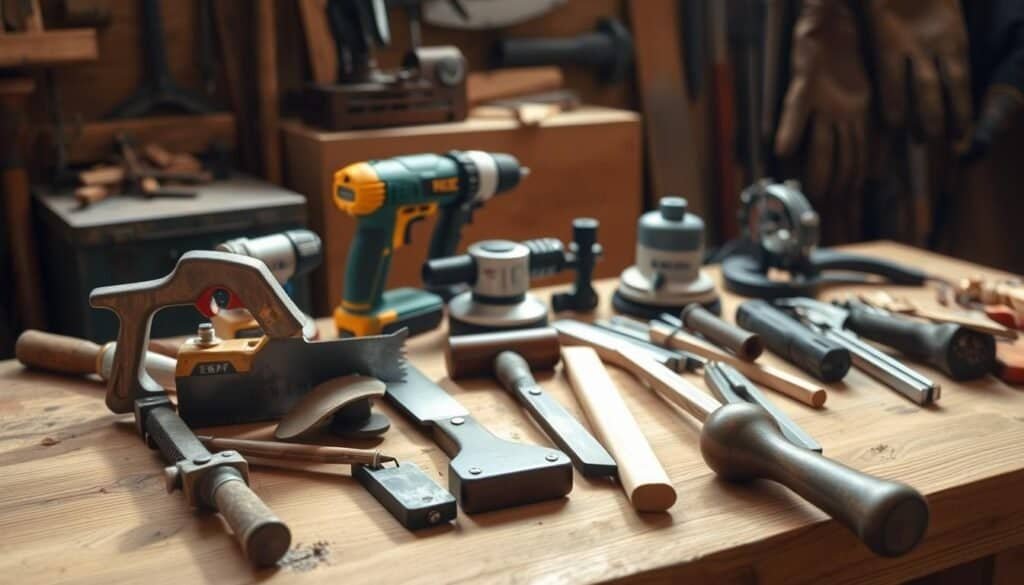
For putting the table together, clamps hold pieces in place, a hammer taps them into position, and a tape measure ensures accuracy. Hand tools like chisels and a hand saw are also necessary. They help with small cuts and adjustments.
Safety Equipment to Keep in Mind
When working on your table, safety is essential. Wear safety glasses to protect your eyes, ear protection to keep your hearing safe, and a dust mask to avoid inhaling dust.
Wearing a workshop apron also helps keep your clothes and skin safe from sawdust. Having a first aid kit nearby is wise in case of accidents.
With the right tools and safety gear, you’re ready to start your dining table project. You’ll work with confidence and efficiency.
Selecting the Right Wood for Your Farmhouse Table
Choosing the right wood is key to making your farmhouse table look rustic and sturdy. The wood you pick affects the table’s look, how long it lasts, and its character.

When picking wood, think about the look you want. Different woods have unique patterns and colors. These can make your table look more rustic.
How long your table lasts is also important. Hardwoods like oak, maple, and walnut are good because they’re strong and don’t wear out easily.
It’s also smart to think about the environment. Using reclaimed wood or timber that’s been sourced sustainably is good for the planet. Reclaimed wood gives your table a special story.
The finish you choose matters too. You can use simple stains or more complex techniques to make the wood look amazing.
In the end, the best wood for your table depends on what you like, your budget, and your project’s needs. By thinking about these things, you can make a table that’s both beautiful and strong. It will be the heart of your dining area for many years.
Planning Your DIY Farmhouse Dining Table Project
For a successful DIY farmhouse dining table project, planning is key. Before starting, make a detailed plan. This will guide you through the process.
Good diy project planning starts with deciding on size and shape. Think about the space and how many people it will seat. Measuring for furniture accurately is essential to fit the table perfectly.

When designing a dining table, consider style, material, and features. Your plan should include a timeline, materials list, and step-by-step guide. This keeps you organized and on track.
Useful project planning tips include setting realistic deadlines and preparing for challenges. Careful planning helps avoid mistakes and ensures a great result.
Classic Rectangular Farmhouse Table Build
Building a classic rectangular farmhouse table adds rustic charm to your dining area. It’s great for family and friends gatherings. With the right steps, you can make a sturdy, lasting table.
First, plan your table’s size, material, and design. A classic farmhouse table has simple elegance with clean lines. Choose reclaimed or distressed wood for a unique, rustic look.
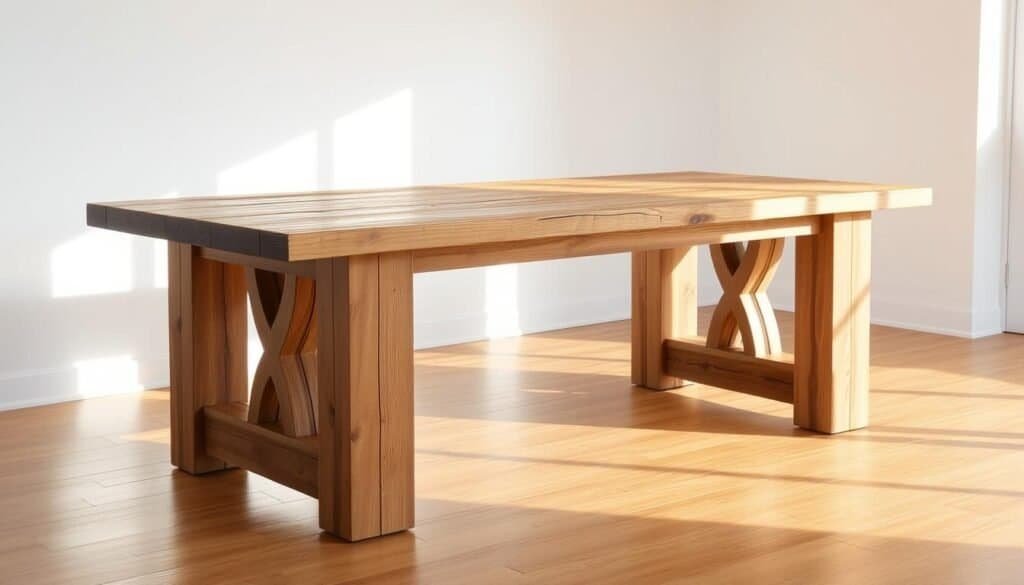
Assembling your table requires careful attention. Use quality hardware and follow proper construction methods. Techniques like mortise and tenon joinery or dovetail joints add strength.
Focus on the details as you build. Ensure the legs are aligned and the tabletop is smooth. With careful planning, your table will be both functional and beautiful.
Follow these tips to build a classic rectangular farmhouse table. It will become the heart of your home. This project is perfect for woodworkers of all levels, challenging and rewarding.
Round Farmhouse Dining Table Project
Creating a round farmhouse dining table requires careful thought. You need to pick the right materials and construction methods. This project adds warmth and elegance to any dining area, unlike traditional rectangular tables.
A round farmhouse dining table is great for cozy meals. It’s perfect for smaller homes or those who love to gather. The round shape makes everyone feel closer and encourages lively conversations.
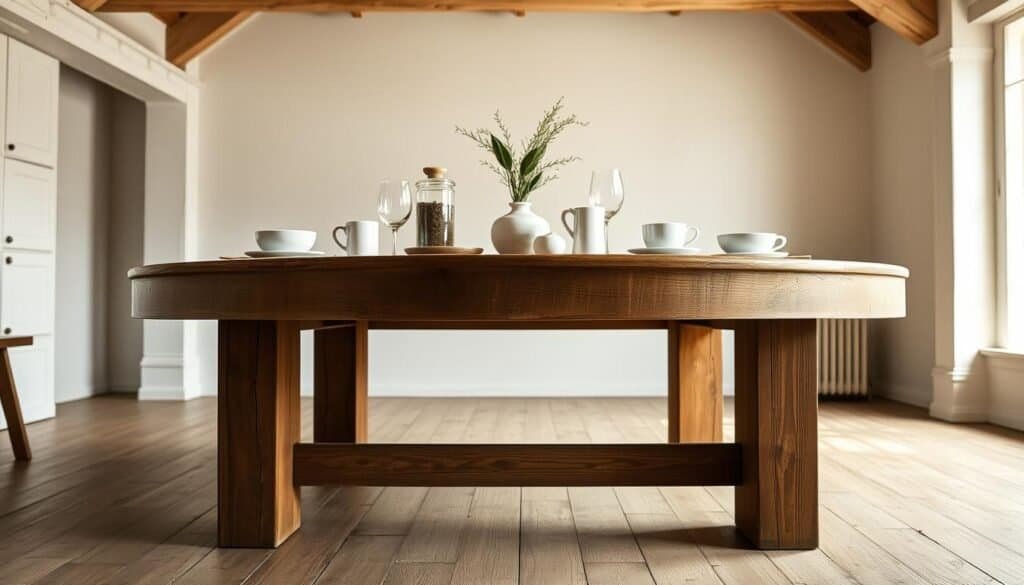
Building a round dining table is different from making a rectangular one. Round tables need special joinery for stability and durability. A strong central leg or base is key to keep the table steady.
The choice of material is also important. For a farmhouse look, reclaimed or distressed wood is best. The round shape highlights the wood grain, adding to the rustic charm.
The table’s size matters too. Round tables can save space but must fit your guests comfortably. You’ll need to plan carefully to find the right size for your needs.
In summary, making a round farmhouse dining table is a fulfilling project. It brings a unique and personal touch to your dining space. With the right design, materials, and construction, you’ll have a beautiful piece of furniture for years.
DIY Farmhouse Dining Tables: Rustic Wood Projects to Build
Building a rustic farmhouse dining table is a fun DIY project. It adds warmth and character to your home. The wood you choose and the techniques you use are key to a great result.
For a real rustic look, use reclaimed or distressed wood. These woods have imperfections that make your table unique and charming.
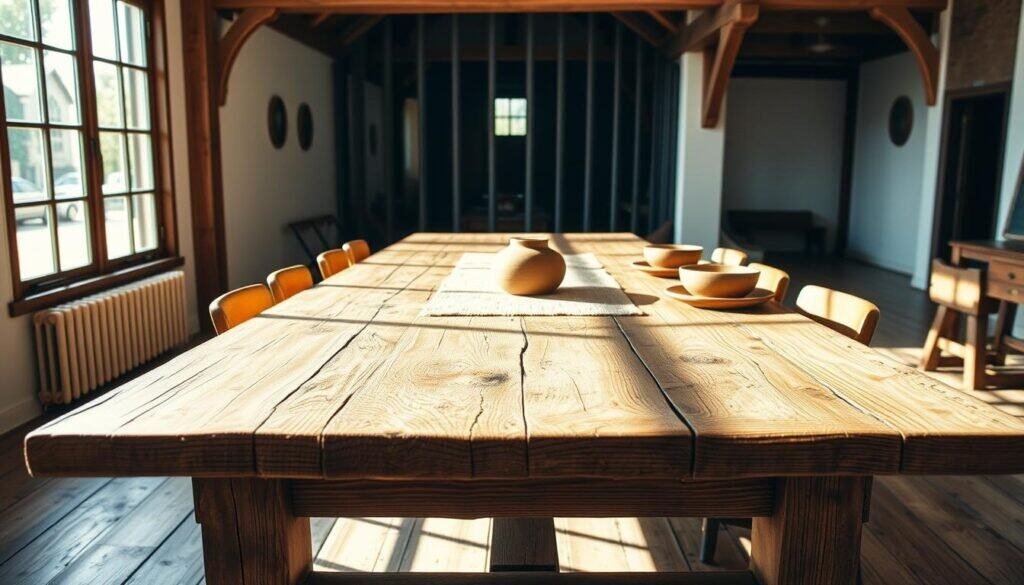
There are ways to make your table look rustic. You can distress the wood to look aged. Using vintage hardware also adds to the rustic feel.
Using rustic woodworking techniques like hand-hewn joints makes your table more appealing. These methods also make your table last longer.
Think about the design of your table. How do all the parts work together? Using rustic wood and techniques will make your table beautiful and useful.
Pay attention to the details and use the right materials. This way, your rustic farmhouse table will show off your style and match your home.
Farmhouse Table with Matching Bench Set
Building a farmhouse table and matching benches creates a welcoming dining area. A well-designed table and bench set can make your dining space perfect for family gatherings and casual meals.
To get a cohesive look, choose a wood type and stain color that match your style. For a rustic look, use reclaimed or distressed wood. Make sure the benches fit well with the table, allowing for comfortable seating and easy movement.
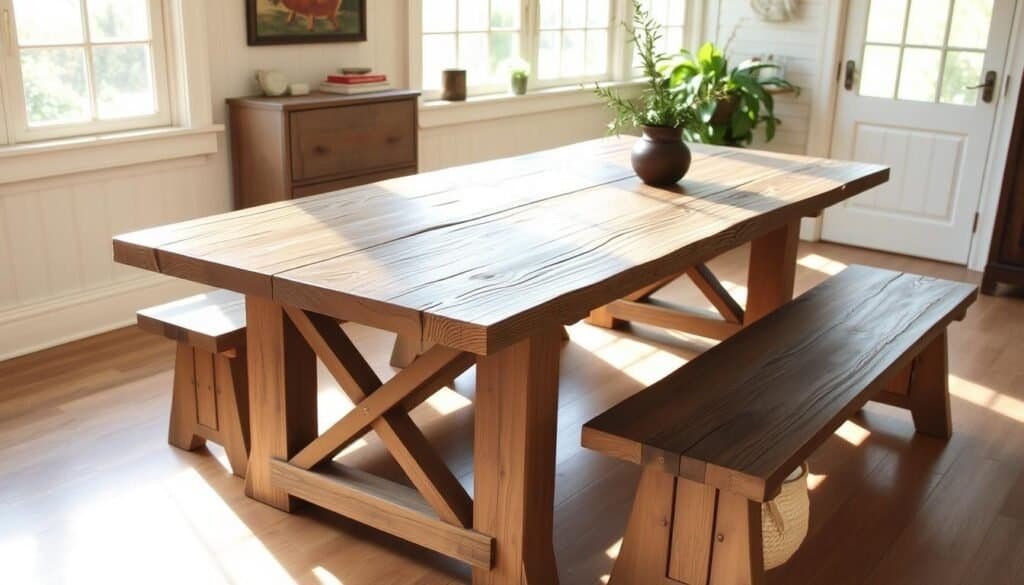
When building benches, use similar materials and techniques to the table. This creates a seamless look. Benches are usually a bit lower than the table for comfortable seating.
The benches should also match the table’s style. For example, if your table has a rustic finish, your benches should too. You can add decorative elements like carved details or metal accents to enhance the look.
By planning and building your farmhouse table and bench set, you create a beautiful dining area. This set not only looks great but also provides practical seating and gathering space.
Essential Joinery Techniques for Sturdy Tables
Joinery techniques are key to making a strong and lasting dining table. The quality of your DIY farmhouse table’s joinery greatly affects its strength and durability. Knowing and using the right joinery methods can significantly improve your table’s construction.
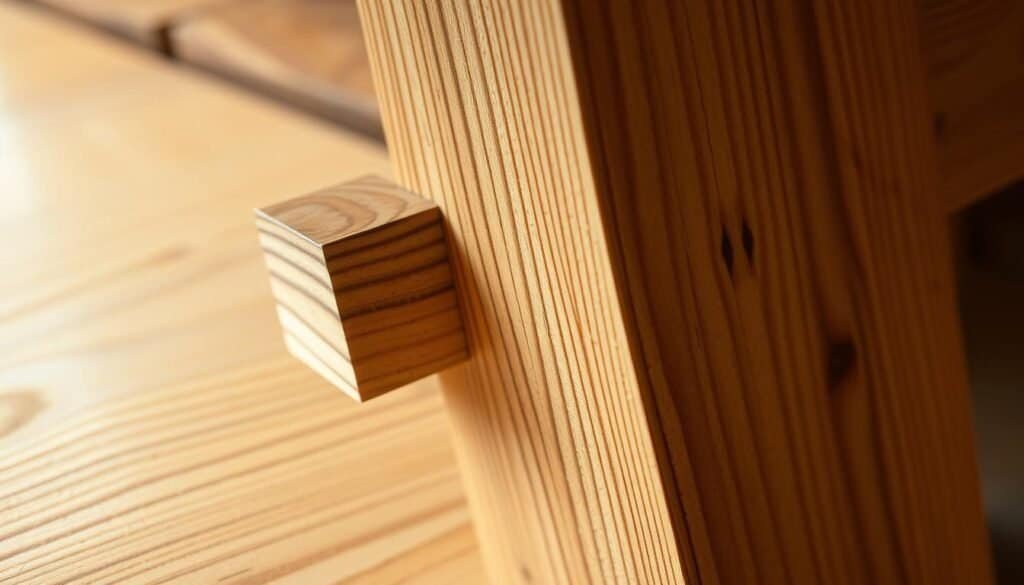
Woodworking uses many joinery techniques to securely connect wood pieces. Mortise and tenon, dovetail, and dado joints are common for building sturdy tables. Each method has its own benefits and uses, based on the design and wood type.
Tips for Strong and Durable Joints
To make joints strong and durable, accurately cut the wood and fit the joints tightly. Use high-quality wood glue and the right fasteners to boost joint strength. Also, adding brackets or screws to key joints can add stability to the table.
Mastering joinery techniques and following best practices for strong joints can help you create a beautiful and durable farmhouse dining table. A well-made table not only fulfills its purpose but also becomes a dining area centerpiece, lasting for years.
Distressing and Aging Techniques for Authentic Rustic Look
Distressing and aging wood are key steps in making your DIY farmhouse table look vintage. These methods give your table a worn, aged look. This adds character and charm.
To distress your wood, you can use tools like sandpaper, chisels, or a hammer. These tools help create dents and scratches. This mimics the wear and tear of time. Wire brushing can also remove soft wood, making the surface textured.
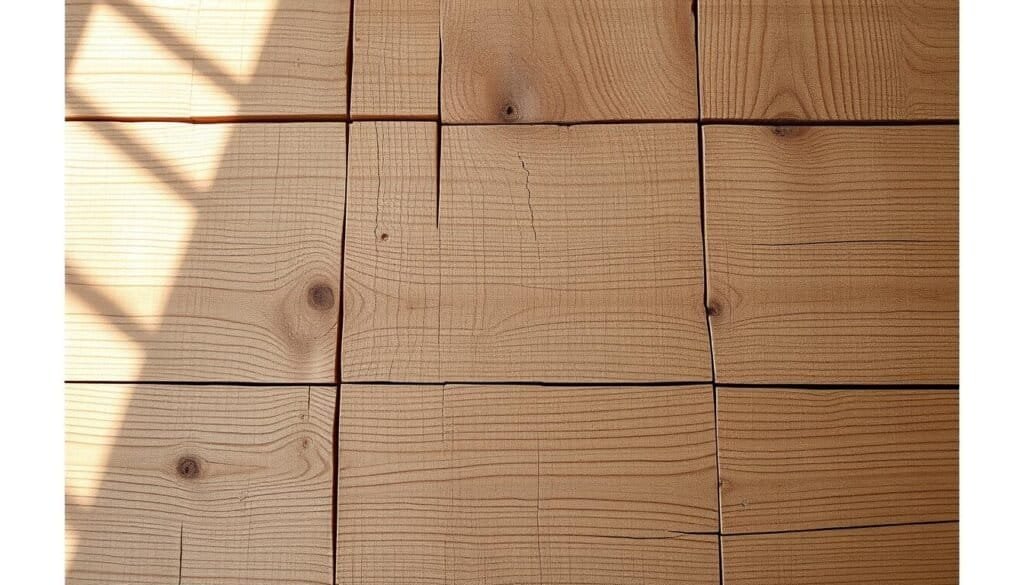
Aging techniques can make your farmhouse table even more vintage. You can use stain and wax to create a layered, aged finish. Applying a patina to metal hardware or components also adds a worn look.
Chemical aging is another method. It involves using a solution that reacts with the wood to create a weathered look. Products designed for aging wood can help achieve this.
By using both distressing and aging techniques, you can make your farmhouse dining table truly unique. These methods let you add a personal touch and character to your DIY project. This makes it stand out.
Staining and Finishing Your Farmhouse Table
Staining and finishing your farmhouse table makes it look great and keeps it safe from damage. A good finish is key for both looks and durability of your DIY project.
Choosing the right wood stain options is important. You can pick from oil-based, water-based, or gel stains. Each type works best with different woods and finishes.
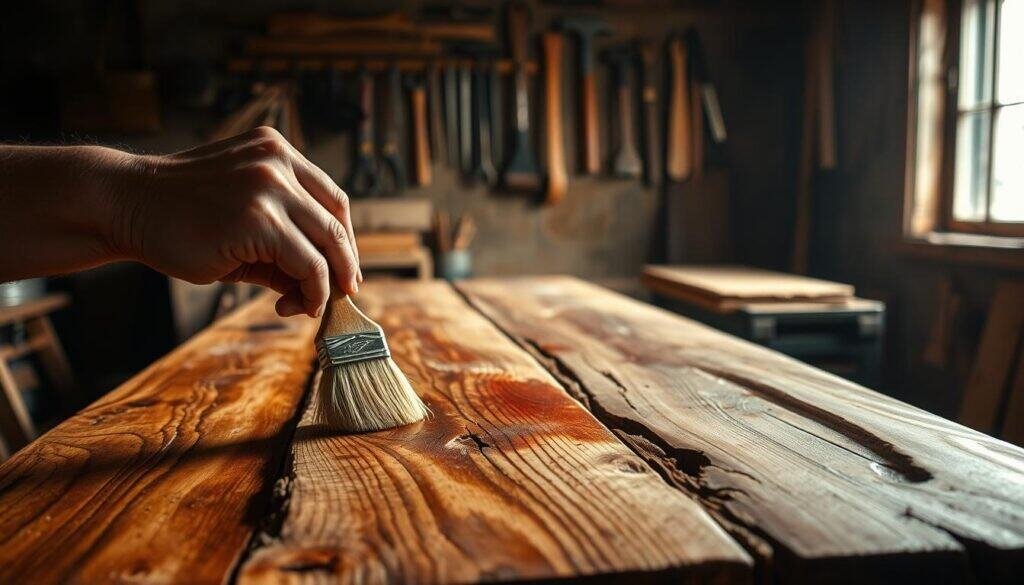
Before staining, you need to get your table ready. Sand the wood until it’s smooth and clean off any dust. Pick a stain that matches the wood’s natural color and grain.
Applying a Durable Finish
After staining, you need to add a durable finish. Finishing techniques include using polyurethane, varnish, or wax. Polyurethane is great for a hard, scratch-resistant surface.
Applying the finish right is important. Use thin coats and let each layer dry before adding the next. This way, you get a smooth finish.
Choosing the right stain and finish, and using the right finishing techniques, will make your farmhouse table beautiful and long-lasting. A well-finished table is not just a centerpiece but also lasts for years.
Troubleshooting Common DIY Table Building Problems
Building a DIY farmhouse dining table can be challenging. You need to be ready for any problems that might come up. Even with good planning, things don’t always go as planned.
One big issue is uneven legs, which can make the table wobble. Make sure all legs are the same length and the floor is even. If it’s not fixed, try using adjustable feet to keep the table stable.
Misaligned joints are another common problem. To fix this, double-check your measurements and clamp the pieces together while the glue dries. If a joint is off, take it apart and reattach it correctly.
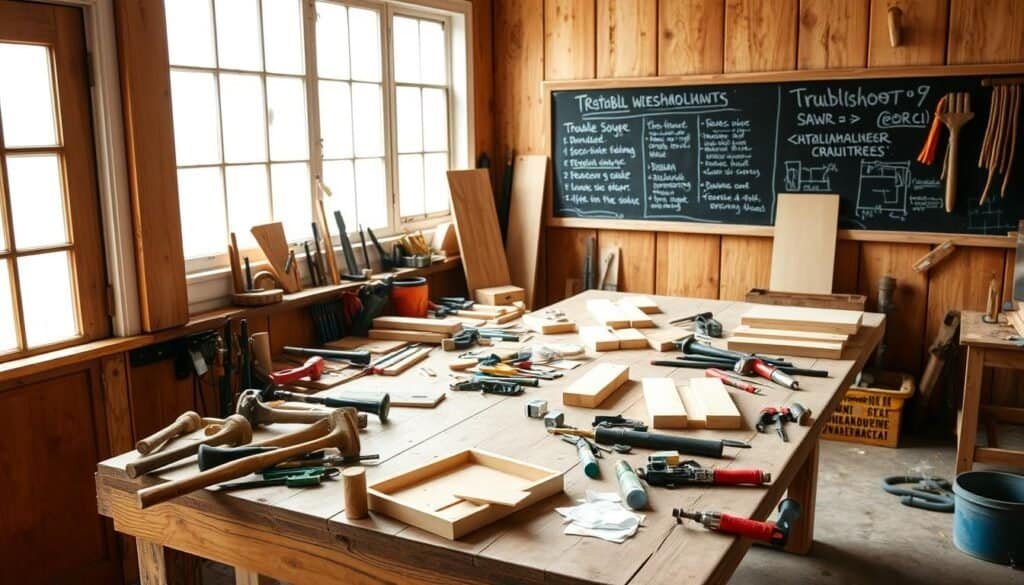
Being patient and prepared is key when facing DIY challenges. Keep a list of common problems and their fixes. Don’t be afraid to ask for help from more experienced DIYers or pros.
Also, a clean and organized workspace helps avoid mistakes. Take your time and don’t rush. With careful planning and attention to detail, you can finish your DIY farmhouse dining table project successfully.
Knowing how to solve common woodworking problems makes you more confident. This skill will help you create a beautiful, functional piece of furniture. You’ll enjoy it for many years.
Conclusion
Building a diy farmhouse dining table is a rewarding project. It adds warmth and character to your home. With the right tools, materials, and techniques, you can create a stunning piece of farmhouse furniture.
In this article, we’ve looked at various rustic wood projects. We’ve also given you tips on how to build your own dining table. From picking the right wood to fixing common issues, we’ve covered everything you need to know.
Now, you’re ready to start making your own diy farmhouse dining tables. The joy of making something with your own hands is unmatched. With these rustic wood projects, you’ll have a beautiful and useful piece of furniture for many years.
So, get your tools ready, pick your materials, and begin building your dream farmhouse dining table. With patience and hard work, you’ll create a table that shows off your style. It will become a cherished family heirloom.

